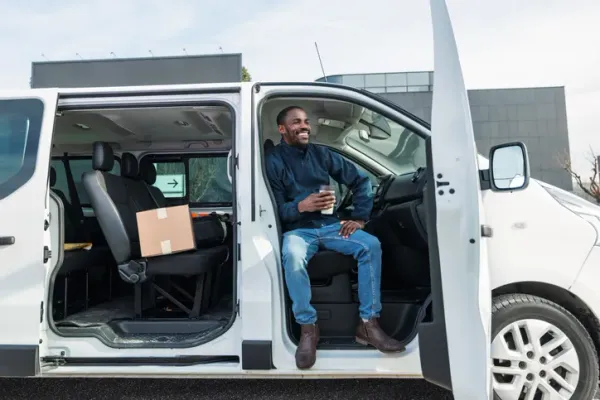A brand new world of carsharing

This post contains affiliate links that HyreCar may receive a commission for referring you to them.
Did you know that you can share your car and make between $8000-$12,000 a year by simply registering it with a carsharing service?
Or, that you can pay a car owner for the use of their personal vehicle for short or long periods of time? Welcome to the brand new world of carsharing.
What is carsharing and how does it work?
In short, carsharing is very similar to Airbnb (sharing spare rooms or homes/apartments), in the sense that car owners allow their personal vehicles to be shared with other drivers for a rental fee. So in reality, carsharing is another form of car renting, but without the long lines or surly customer service reps behind the airport rent-a-car counter. Here are some differences between carsharing and renting a car from an agency:
Unlike regular car rentals, where you pay a steep daily fee to rent a car from huge agencies like Hertz or Avis for long periods of time, vehicle sharing can involve renting a car from an individual for a very short period of time, like maybe an hour or two. You’re only billed for how long you have the car and the distance you travel in it. Gas and auto insurance are sometimes already included in the rental fee, which is typically calculated like this:
Carsharing service membership fee + what you pay per hour/day + miles driven (depending on your rate plan) = your rental fee.
Another convenient difference between carsharing and traditional car renting is that you can usually find a car parked and waiting 24/7 in one of several reserved lots around the city you’re in. This is great for emergencies when you need a vehicle really late at night or before dawn, so you don’t have to work around the business hours of a rental car agency.
Here’s how to find and access a car share rental vehicle. It’s really easy.
- Search Google for carsharing companies in your area. Several should pop up.
- Go over their membership requirements as each company’s contracts may be different. For example, HyreCar, a carsharing marketplace for ridesharing, is contract free. Renting a shared vehicle with HyreCar is simple.
- Create an account, select a vehicle from a full-range of different styles and models and click “book now” to reserve it. You can reserve more than one in case your first choice becomes unavailable for some reason. You’re only charged for the car you are approved for first.
- Fill out the online application form, along with some personal information and select how long you would like to initially book a vehicle.
- Once the car owner approves your application, you’ll receive documents with important information about the car, such as the registration, a 19-point inspection, and ridesharing insurance that you’ll upload to the ridesharing service you’re going to drive for, such as Uber or Lyft.
- Arrange a time and place to meet the car owner, give it a quick inspection to note any existing damage, take possession of the keys, and start driving! See? We told you HyreCar makes renting a shared vehicle easy!
The difference between carsharing and ridesharing
OK, let’s talk about differences between the carsharing industry and the ridesharing industry.
With carsharing, also known as auto-sharing, a person needing a vehicle can have access to someone else’s private car for a short period of time by renting it when car ownership itself is not feasible. This is an excellent alternative form of transportation in densely populated cities with unreliable or confusing mass transit systems, high costs of car ownership related to parking and insurance, or expensive taxi services. City carsharing is getting more popular every year.
There are different kinds of carsharing:
- Peer-to-Peer carsharing
Car owners register their vehicles with carsharing services so that individuals needing a private car can rent it for short time periods. The specialized software matches potential renters with owners whose cars are available for immediate usage. This is also known as peer-to-peer rental. - Airport carsharing
You leave your car parked at the airport while you’re on vacation, and allow someone else to rent it while you’re gone. - Business to Consumer (B2C) carsharing
A large company owns numerous cars that can be rented directly by members of carsharing programs instead of them going through an agency. - Not-For-Profit or Co-Op carsharing
Local non-profit organizations promote the use of shared vehicles for social and environmental purposes instead of as a money-making business.
The original definition of ridesharing was another way of saying carpooling. A person who owns the car and a group of passengers drive together from a convenient location to a common destination, like school or the office. This was, and still is, a convenient way for groups of friends or co-workers to get from one place to the other on a regular basis. But it still requires passengers in the carpooling group to own, fuel up, and maintain their vehicles.
In the age of smartphones and online platforms, ridesharing services like Lyft and Uber realized that passengers seeking one-way rides could be matched with drivers looking to earn some extra cash. Modern ridesharing was born and continues to grow, with $1.5 trillion in profits projected to be added to the auto industry by 2035.
To sum it all up, private carsharing is when an owner of a car rents it out through a service to a driver in need of a vehicle for a short period of time. ridesharing is either group carpooling or when a passenger in need of a ride hires a Lyft or Uber driver through a smartphone app to take them on a one-way trip to a local destination. Need a vehicle? HyreCar.com provides a carsharing marketplace specifically for ridesharing.
Advantages of carsharing
There are lots of advantages when it comes to carsharing:
- Flexibility: If you register with a carsharing service, you can rent a privately owned vehicle anytime, day or night. No need to worry about rental car agency business hours.
- Convenient locations: If you’re living in or visiting a big city, chances are good there’s a parking lot reserved for carsharing vehicles near you, possibly within walking distance.
- Ease: Use a mobile app or Google search to find the location of the closest available car that you’d like to rent. Most carsharing services can get you on the road in as little as 24 hours!
- No car ownership costs: Owning a car is expensive, what with rising gas prices, skyrocketing insurance rates, and costly repairs, not to mention outrageous parking garage fees if you live in a densely populated city with little to no street parking. And most of the time, your own personal car is sitting unused for hours while you’re doing other things. It can easily cost you up to $10k a year to own a car that you only use several hours a week.
- No expensive rental agency fees: When you use a carshare service, your daily car share fees are much less than renting a car from an agency, especially if you’re only using the car for a few hours. Carshare rates are typically measured in hours, days, or miles. You’re really only paying for the time you’re in the car. Gas, maintenance, and sometimes even parking fees are covered in your payment.
- Vehicle choice: You can choose from all kinds of vehicles. Drive around on errands in a family sedan during the week and then tear up the dirt road in a 4×4 on the weekends. Hybrids, luxury cars, electrics, and minivans are at your fingertips.
- Environmentally friendly: Carsharing reduces traffic congestion, dependency on fossil fuels, and air pollution. Studies show that one shared car takes 15 privately owned vehicles off the road, while carsharing in general annually reduces global carbon dioxide emissions by nearly 500,000 tons!. Another study claims that drivers who frequently rent privately owned cars tend to walk and bike more to nearby destinations, which is really healthy.
Why app-based carsharing beats taking mass transit
Everyone from families to professionals to students are discovering that carsharing is a much better alternative to dealing with the hassles of public transportation. Why take a stinky old bus or a crammed commuter train for a short ride when you can drive a nice, clean, comfortable car yourself, or be a passenger in one?
- Carsharing allows you to rent a car and drive on your own schedule, not the set-in-stone schedule of mass transit, which tends to run late anyway. So no more waiting outside in bad weather at a bus stop or navigating through a dank and dirty underground subway station.
- Depending on the size, and how many people are in your party, one shared vehicle can fit up to 6 passengers. The cost is split, proving that carsharing solutions are more inexpensive than taking mass transit.
- Easy online booking means you can reserve a space in a shared car in advance. You can also learn who the driver is, the car model, and how much the rate is to be before getting in the car. That’s better than boarding a bus or train and discovering it’s standing room only.
- Carshare rides let you meet new people during a relaxing journey. Who knows? Your soul mate could be sitting next to you in the backseat!
- Worrying about making the bus or train on time before it leaves can make you sick with anxiety.
How safe is carsharing?
Let’s face it, anything can happen when you hit the road, whether you’re driving cross-country or across town. Accidents do happen. If you’re a safe and conscientious driver, chances are you and your passengers will be safe, too. In general, carsharing is safe, but there are always common sense ways to sustain your safety.
- Carsharing services do a full background check on renters, and they will not accept a potential driver with numerous accidents or violations. So if you’re part of a carsharing carpool group, odds are everyone in the car, including you, will have a good driving record.
- Cars that have been in reported to be in numerous accidents most likely won’t be accepted as shareable vehicles.
- If you’re picking up a car late at night in an urban parking lot, check to make sure the lot is well lit, observe your surroundings, and if possible, take a friend with you.
Carsharing vehicle insurance:
Ok, now you’re thinking, “Hey, thanks blog writer! I want to rent out my car and make some extra cash!” Yes, sharing your own car with random drivers in need of a vehicle is an easy way to put your unused car to work so you can rack up some easy passive income. However, things can get a little tricky when it comes to insuring a privately owned car that renters will be driving.
Here’s the good news about carsharing insurance coverage:
- Most of the big carsharing companies offer their own auto insurance policies to vehicle owner, so you can rent your car with confidence.
- Policies typically cover accidents and/or injuries caused by the renter while he/she is driving your car, damage to your car caused by other cars while the renter is using yours, and even theft of your vehicle when it’s in your renter’s possession.
- Policies may vary from company to company and state to state, but most offer liability, collision, and comprehensive insurance for the time period that your car is being rented. Compare carsharing services’ policies carefully before signing your car up for use.
Here’s the not-so-good news about carsharing insurance coverage:
Some personal auto insurance companies may deny you automobile coverage during the period when a renter is driving your shared vehicle.
However, HyreCar offers proprietary rideshare insurance while your car is being rented, so you’re always covered! They also provide “Period X Insurance” that protects you, your carsharing business, and your vehicular assets while they are not rented on the HyreCar platform.
The future of carsharing looks bright
Carsharing is a massive business, and it’s getting bigger every year. Along with the rise in popularity with services like Airbnb, 900,000 Americans use carsharing services every year. Huge automakers like General Motors are beginning to partner up with ridesharing companies like Uber. And according to Global Market Insights, the carsharing market is projected to undergo double-digit growth with an estimated revenue of over $16 billion (yes, BILLION) in less than ten years from now.
So, should you share your vehicle through a service?
OK, now you know the ins and outs of carsharing and you’re shouting “I want to share my car and make money!”
Here are some tips for success when listing your vehicle with HyreCar:
Create an eye-catching, attention-grabbing car listing on HyreCar:
- We strongly suggest uploading high-quality photos of your car so a potential renter can really see its style, color, and condition. Fuzzy or dimly lit photos tend to be ignored.
- Write a short but accurate description of your car. Tell potential drivers why you’re a good person to rent from as opposed to other owners. Be creative, but keep it simple.
- Make sure you upload the necessary documents detailing vehicle registration, auto insurance coverage, 19-point inspection review, and your driver’s license.
- Note: If you still need to get your vehicle inspected, check out our friends at Rideshare Mechanic to get your vehicles inspected remotely. This service conducts a video vehicle inspection, which eliminates the inconvenient process of going to a Jiffy Lube or local mechanic.
Do some research on the local carsharing market in your area:
- Compare listings that other owners post to find out what they charge for renting their cars in your market. This way, you won’t charge too high or too low of a rental fee.
- Reach out to owners with high bookings. Chances are they’ll give you some listing tips.
- Analyze the driver demand in your market. Look into what kind of cars are rented the most.
- Let potential drivers know exactly when your car is ready for renting.
Approving your first vehicle application:
- Once you receive an application from a driver, you will have 24 hours to approve it, or else it will expire and you’ll lose out on that opportunity of passive income.
- You can always start out by renting your car two days a time to get used to the process. Then start renting it for longer periods when you’re ready. The average rental is fourteen days.
Preparing and maintaining your car:
- Treat your car to a good cleaning inside and out, and fix any major damage like huge dents or scratches. If your car looks as nice in person as it does in photos, you’ll get more bookings.
- Always inspect your vehicle after a rental to confirm it’s in the same condition it was before you handed over the keys to a driver. This will help you maintain its condition. Use a portion of your profits to keep it looking nice.
Build a relationship with renters:
- Get to know your renters a bit. Introduce yourself with a handshake in person or by text. Thank them for renting your car to show them that you see them as a person in need and not just a source of income.
- Feel free to check in with them while they have your car in case they have a question, or to just ask how things are going.
What to do when the rental period is over:
- When the driver returns your car, click “Confirm Drop Off” on the app.
- Check your car for damages inside and out. If there is any damage, take photos and contact HyreCar support right away. Also contact the support team If the driver is late returning your car, even if they contact you to tell you they’re running late.
Conclusion
So, whether you rent your car to a driver through a carsharing service for an hourly, daily, or monthly car share rate, sharing your car can make you money, help out someone in need of a ride, and reduce traffic congestion and environmental pollution. Happy carsharing, everybody!



